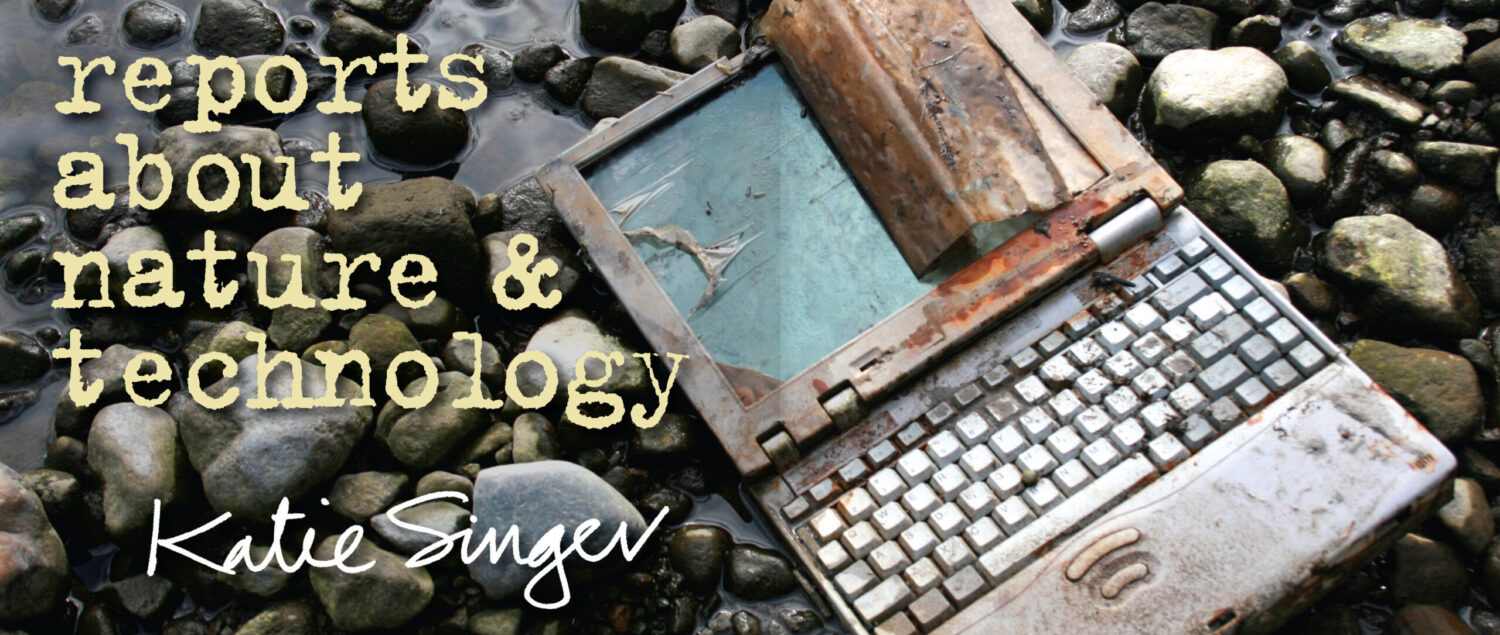Could we make questioning technology…common?
Could we make tech’s harms and remedies more visible?
by Katie Singer
Technological developments have given our food extended shelf life, washed our clothes, sped transportation and communications, cleared diseases and infections. Computers can predict weather, collect and analyze data about pollution, identify forest fires when they are small—and much more. We know these stories well—while technology’s unintended consequences remain invisible.
In the early 1970s, manufacturers transformed Santa Clara County, California from a place for fruit orchards to Silicon Valley. They named the rooms for sterilizing computer chips “clean.” The unsuspecting public did not know those factories’ toxic impacts on ecosystems or workers’ health—until they got sick from their drinking water and noticed a startling rise in miscarriages and babies born with birth defects.
Unless the public knows how the Internet, solar PVs, industrial wind systems, electric vehicles and batteries degrade ecosystems and public health, it likely won’t pressure manufacturers to develop healthier practices for manufacturing, operating and discarding our tools; and manufacturers will likely be unmotivated to change.
Could we make questioning the technologies that surround us…common?
In Voices of a People’s History of the United States in the 21rst Century, the just-released update to Howard Zinn’s A People’s History, editors Anthony Arnove and Haley Pessin present writing about social movements including Black Lives Matter, #MeToo, Indigenous struggles, immigrant rights, the environmental movement, disability justice and frontline pandemic workers.
Neither book challenges technology’s ecological or social harms.
Could we make reporting on our technosphere’s harms…common?
Telecom corporations now aim to end wired phone service in California. Without landlines, emergency calls can occur only by mobile service—which can fail without electric power (an increasingly common emergency).
Without landlines, only mobile phones and voice-over-Internet protocols (VOIP) are available. Alas, mobile devices, Wi-Fi routers and cellular antennas emit electromagnetic radiation (EMR). EMR and screen-time exposure have been linked to addiction, anxiety, attention deficit disorder, autism, cancer, dementia, depression, vision problems and much more. In-utero exposure to a cell phone’s radiofrequencies increases children’s risk of behavioral problems by the time they reach school-age by 85%. Besides withdrawing from society, what can protective parents do? (Limiting social media use to 30 minutes/day reduced college students’ loneliness and depression.)
Could we make remedy for techno-harms…common?
Artificial intelligence takes away jobs, traditional know-how and the eye-to-eye or voice-to-voice contact that creates our social fabric. Recently, after trying to pay a bill online, I admitted that I need to learn to relate with robots without harming myself.
Surveillance capitalism abounds. “Smart” utility meters track what appliances and devices you use and when you use them; utilities sell this data to marketers. Newer cars track where you work, shop, socialize. French police may now access suspects’ location through suspects’ devices.
All electronics—including mobile phones, cell towers, smart utility meters, solar PV systems, electric vehicles—pose fire hazards. With 5G (fifth generation of mobile access networks), cell sites’ fire hazards and EMR emissions get much closer to our homes.
Electronics do not biodegrade. Could we design electronics for their second life—and keep them out of landfills…longer?
We live in the technosphere like the mythic frog who doesn’t notice that the surrounding water’s rising temperature threatens its survival. Let’s build awareness of technology’s hazards. Let’s ask: If our survival depend on limiting our technology use, what limits do we need to learn?
What I’m reading:
In “The Sky-High Cost of Deep-Sea Mining,” Planet Tracker reports that deep sea nodules contain manganese, nickel, copper, cobalt, molybdenum, iron, gold, zinc, lead, barium, silver and sulphides—elements necessary for computers, solar PV and wind power systems and electric vehicles. Because nodules take tens of millions of years to form, deep-sea mining would cause permanent habitat and biodiversity loss. Over half of the species living in the Pacific abyssal plains depend on nodules. Sound from a single nodule mining operation could travel up to 500 km. Within a 4-6 km radius, mining sound would exceed 120db, the threshold that can impact marine mammal behavior. Seabed mining is unlikely to reduce terrestrial mining-related deforestation significantly. Would financial institutions support a moratorium on deep sea mining?
John E. Young’s extraordinary booklets, Mining the Earth and Global Network: Computers in a Sustainable Society, written in the early 1990s for Worldwatch, report on mining’s potential impacts (destruction of wildlife habitat and human settlements; metal contamination of waterways; sulfur dioxide, arsenic, lead and other toxins emitted into air; abandoned mines). The greatest challenge to using less-damaging materials and creating more durable electronics lies in developing strategies “that allow poor countries to improve human welfare dramatically without using and discarding hundreds of kilograms of metals and other minerals per person each year. Roughly three fourths of the world’s people now live in countries (without) the railways, roads, bridges, buildings and other basic infrastructure so essential to rich nations’ economies.” Finally, he observes that the greatest environmental benefits come usually from altering “production processes and consumption patterns, rather than through ‘pollution control.’”
Max Wilbert sees Thacker Pass as a spiritual battleground. If you don’t know about the lithium mining at Thacker Pass, Nevada, check out: https://katiesinger.substack.com/p/wilbert-on-lithium and https://katiesinger.substack.com/p/june-2023-newsletter.
In 1978, The Schumacher Center’s Robert Swann outlined “Appropriate Technology and New Approaches to Ownership.” He proposed technologies that are: 1) Simple to use, maintain and repair—and thereby promote local self-reliance. 2) Labor intensive (not capital and energy-intensive). 3) Constructed from local materials whenever possible and adapted to local needs. 4) Designed for less destructive environmental impacts.
Siemens Energy shares plunged by one third after it reported that its wind turbine components degrade faster than expected.
Sapien Labs just published “Age of First Smartphone/Tablet and Mental Wellbeing Outcomes.” Children raised with smartphones may have diminished social capacity and resilience; they may harbor more frequent suicidal thoughts and aggressive feelings. The authors report that delaying smartphone acquisition seems helpful.
KATIE SINGER writes about technology’s impacts on nature. She believes that if she’s not aware of the problem, then she can’t be part of the solution. She dreams that every user learns about the supply chain of one substance in their computer. Her books include An Electronic Silent Spring, Honoring Our Cycles and The Wholeness of a Broken Heart. Visit https://katiesinger.substack.com, https://OurWeb.tech and https://ElectronicSilentSpring.com.
Sign-up for a free or paid Subscription to Katie Singer’s Substack

